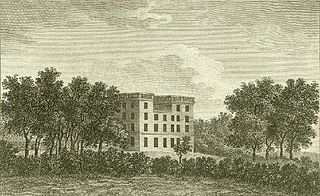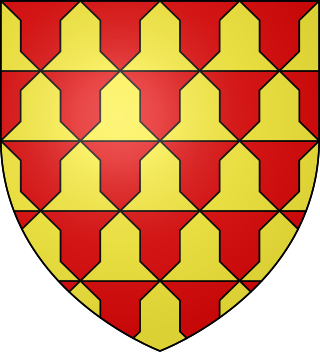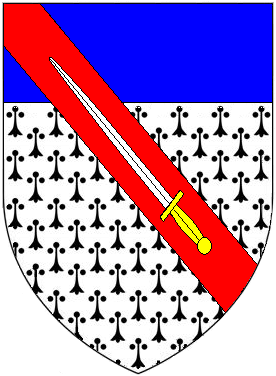
John Colepeper, 1st Baron Culpeper was an English peer, military officer and politician who, as Chancellor of the Exchequer (1642–43) and Master of the Rolls (1643) was an influential counsellor of King Charles I during the English Civil War, who rewarded him with a peerage and some landholdings in Virginia. During the Commonwealth he lived abroad in Europe, where he continued to act as a servant, advisor and supporter of King Charles II in exile. Having taken part in the Prince's escape into exile in 1646, Colepeper accompanied Charles in his triumphant return to England in May 1660, but died only two months later. Although descended from Colepepers of Bedgebury, Sir John was of a distinct cadet branch settled at Wigsell in the parish of Salehurst.

Sir Joshua Jebb, was a British officer of the Royal Engineers who participated in the Battle of Plattsburgh on Lake Champlain during the War of 1812, He became Surveyor-General of convict prisons. By 1850, Pentonville Prison which he had designed had become a template for prison construction across the British Empire. Michael Ignatieff described Pentonville as "the culmination of a history of efforts to devise a perfectly rational and reformative mode of imprisonment".

Ashover is a village and civil parish in the English county of Derbyshire. It is in the North East Derbyshire district of the county. The population of the civil parish taken at the 2011 Census was 1,905, increasing to 1,959 for the 2021 census. It sits in a valley, not far from the town of Matlock and the Peak District national park.
William I de Ferrers, 3rd Earl of Derby was a 12th-century English earl who resided in Tutbury Castle in Staffordshire and was head of a family which controlled a large part of Derbyshire known as Duffield Frith. He was also a Knight Templar.

This is a list of Sheriffs of Derbyshire from 1567 until 1974 and High Sheriffs since.

Tupton Hall was a former mansion, in Tupton, near Wingerworth in North East Derbyshire, 4.5 miles (7 km) south of Chesterfield. Since its demolition following a fire in 1938 it has been the site of Tupton Hall School, a secondary comprehensive school.

Samuel Pegge "the Elder" was an English antiquary and clergyman.

Sir John Port was an English landowner and Knight of the Order of the Bath who served occasionally in the House of Commons. He was High Sheriff of Derbyshire in 1554. By his will, he founded Repton School and almshouses at Etwall. He also owned Caverswall Castle from 1531 after acquiring it through marriage to Elizabeth.

Robert de Ferrers, 6th Earl of Derby (1239–1279) was an English nobleman.

There have been two baronetcies created for persons with the surname Boothby, both in the Baronetage of England. One creation is extant as of 2022.

Tapton is a suburb of Chesterfield, in the county of Derbyshire, England. It is located along the Brimington Road B6543, between Chesterfield town centre, and Brimington. It became a suburb of Chesterfield in the 1920s. The buildings along Brimington road, which runs through the centre of Tapton, are testament to this fact. Consisting of semi-detached houses in a style typical of the 20s and 30s.

The Hunloke Baronetcy, of Wingerworth in the County of Derby, was a title in the Baronetage of England. It was created on 28 February 1643 by King Charles I for Sir Henry Hunloke, of Wingerworth, near Chesterfield, Derbyshire. Hunloke was a loyal royalist who had been knighted by the King on the battlefield of the Battle of Edgehill the previous year. The baronetcy passed from father to son until the death of the sixth Baronet in 1856. The latter was succeeded by his uncle, upon whose death in 1856 the baronetcy became extinct. The second Baronet was High Sheriff of Derbyshire in 1687 and the sixth Baronet in 1840.
Sir Francis Foljambe, 1st Baronet was Member of Parliament for Pontefract in 1626 and High Sheriff of Derbyshire in 1633.

Ogston Hall is a privately owned 18th-century country house situated at Brackenfield, near Alfreton, Derbyshire. It is a Grade II* listed building. A building on the site is listed in the Domesday Book as part of the Deincourt manor of Morton. The Revell family of South Normanton held Ogston in the 14th century by marriage to the Deincourt heiress.
Sir Thomas Fairfax was an owner of Gilling Castle, near Gilling East, North Riding of Yorkshire, England.
Richard Bland I, sometimes known as Richard Bland of Jordan's Point, was a Virginia planter and member of the Virginia House of Burgesses, and the father of Founding Father Richard Bland.

Thomas Gladwin of Tupton Hall, in the parish of Wingerworth near Chesterfield, Derbyshire, was Sheriff of Derbyshire in 1668.

St Bartholomew's Church, Clay Cross is a Grade II listed parish church in the Church of England in Clay Cross, Derbyshire.

Holymoorside and Walton is a civil parish within the North East Derbyshire district, which is in the county of Derbyshire, England. Named for its main settlements, with a mix of a number of villages and hamlets amongst a large rural area, it had a population of 2,138 residents in 2021. The parish is 130 miles (210 km) north west of London, 20 miles (32 km) north of the county city of Derby, and 2 miles (3.2 km) south west of the nearest market town of Chesterfield. It is adjacent with the Peak District national park to the west, and shares a border with the district of Chesterfield, along with the parishes of Ashover, Beeley, Brampton as well as Wingerworth. The parish paradoxically does not include the majority of the nearby built-up suburb of Walton, Chesterfield which is now within an adjacent unparished area of the borough.

The Hancornefamily were a prominent landed family living chiefly in the English counties of Warwickshire and Herefordshire, and the Welsh counties of Breconshire and Glamorgan, between the Caroline era and the 19th century.



















